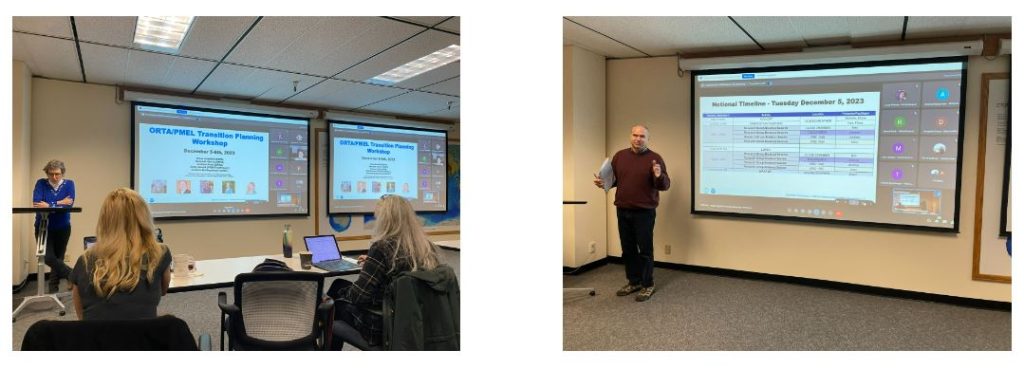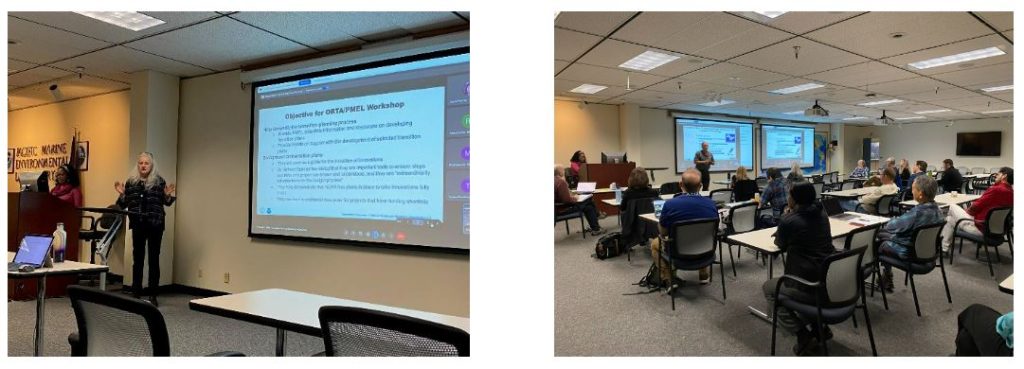Article and Figures Provided By ORTA and PMEL
Figure 1: ORTA-PMEL Transition Planning Workshop coordination team. (Left to right, back to front) Fiona Horsfall, James Shambaugh, Annette Hollingshead, Andrew Peck, Diane Stanitski, Eugene Burger, Abigail Arnold, Darrin Moore, with Kenneth Vierra and Joyce Pinkney kneeling. (Darrin Moore is Deputy Director of UxSRTO and was onsite for other meetings. Eugene Burger is Director of the PMEL Research Services Division and participated in the workshop)
On December 5-6, 2023, the Office of Research, Transition, and Application (ORTA) held a transition planning workshop at the Pacific Marine Environmental Laboratory (PMEL) in Seattle, WA to help demystify the transition planning process and provide PMEL scientists with information and resources needed to develop transition plans. Transition plans play a critical role in accelerating and facilitating the transition of research and development (R&D) within NOAA to operations, applications, commercialization, and other uses. Fiona Horsfall, the director of ORTA, ORTA transition planning support staff Kenneth Vierra, Andrew Peck, and Abby Arnold, and Annette Hollingshead from the Atlantic Oceanographic & Meteorological Laboratory (AOML) were on-site for the 2-day workshop to assist and provide guidance in the development of PMEL project transition plans.
Developing a transition plan is best done with a transition team consisting of 1) the R&D team such as project principal investigators (PIs), co-PIs, and/or federal points of contact; 2) adopter(s) and/or end-user(s) such as operational partner(s) and/or LOs; and 3) line office (LO) leadership including lab director(s), R&D and adopting LO AA(s). For extramural R&D, points of contact from the NOAA funding program and/or end user are also an important part of the transition team. The full transition team typically assists the PI as needed and, in some cases, is responsible for coordinating transition activities and assisting with identifying, reporting, and responding to significant deviations in the execution of the transition plan. The purpose of this workshop was to familiarize PMEL scientists with the transition plan process and provide tailored guidance with their teams for individual project needs.

Figure 2: ORTA Engagement with transition planning and process
PMEL staff including Diane Stanitski (Deputy Director), James Shambaugh (Ocean Environment Research Division (OERD) Director), and Joyce Pinkney (Administrative Specialist) were instrumental in setting up workshop logistics. Roughly 30 PMEL scientists and engineers participated in the workshop, attending sessions over the two-day period. The majority of the sessions were in-person, but virtual options were also available.

Figure 3: PMEL Director, Michelle McClure (left) provides opening remarks and James Shambaugh (right) provides the notional timeline
Following an introductory briefing by ORTA, principal investigators (PIs) had the opportunity to discuss their projects one-on-one with transition plan support staff. They discussed transition plan template options and how to assess the best template to use moving forward. A common topic in each session was the dependence of the creation of transition plans upon the maturity of the readiness levels (RLs) of project components (https://orta.research.noaa.gov/plans/).

Figure 4: ORTA transition plan Templates (https://orta.research.noaa.gov/plans/)

Figure 5: Fiona Horsfall (left) and Kenneth Vierra (right) providing the introductory briefing by ORTA

Figure 6: Annette Hollingshead discusses the modular transition plan structure
Annette Hollingshead discussed the modular transition plan structure, which is aimed at projects that will likely include additional, very similar, transitionable features or components in the future. AOML works closely with PMEL on many projects, so this provided an additional opportunity for discussion and collaboration.
Transition plans are important tools that help to ensure project success. They facilitate communication and coordination between the R&D entity and end-user(s), providing a clear path from start to finish. They document clear requirements, potential project risks, and intended resources. By identifying potential risks early in the project, mitigation efforts can be put into place to avoid delays or potential pitfalls. Working within the NOAA budgetary cycle, it is key to identify required resources well ahead of time. A transition plan helps provide a vision or road map to include: 1) potential rough-order-of-magnitude (ROM) costs; 2) potential funding sources for operational or regular use; 3) early identification of the end users or adopters of the technology; and 5) a description of the ultimate benefit and how it meets NOAA mission needs. The R&D might have far reaching benefits that go beyond the initial scope of a project, but the primary intent will be articulated in the transition plan. Transition plans can lead to additional resources for projects that have funding shortfalls.
After each day’s sessions, the workshop team met to review the day’s activities and record notes for follow-on actions.

Figure 7: Daily hotwash meeting with ORTA and PMEL staff
The workshop was very informative and the ORTA team enjoyed learning about the innovative science and potential transitions that PMEL scientists are working on. The PMEL team expressed their gratitude for the guidance provided from ORTA during the workshop. Both offices are looking forward to working together on the development of transition plans as a follow-on to this workshop. All principal investigators who participated were provided tools, resources, and knowledge to complete transition plans in a timely manner.
ORTA works with all Line Offices, laboratories, and teams to develop and iterate on assembly of the pieces of the puzzle to create a vision or roadmap for R&D project(s). ORTA can assist and facilitate the development of transition plans from start to finish, including shepherding it through the signature process. Anyone looking to engage with ORTA in the transition plan process can contact the team at oar.orta@noaa.gov.
